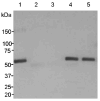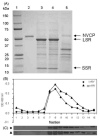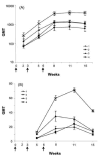An efficient plant viral expression system generating orally immunogenic Norwalk virus-like particles
- PMID: 18325641
- PMCID: PMC2744496
- DOI: 10.1016/j.vaccine.2008.01.053
An efficient plant viral expression system generating orally immunogenic Norwalk virus-like particles
Abstract
Virus-like particles (VLPs) derived from enteric pathogens like Norwalk virus (NV) are well suited to study oral immunization. We previously described stable transgenic plants that accumulate recombinant NV-like particles (rNVs) that were orally immunogenic in mice and humans. The transgenic approach suffers from long generation time and modest level of antigen accumulation. We now overcome these constraints with an efficient tobacco mosaic virus (TMV)-derived transient expression system using leaves of Nicotiana benthamiana. We produced properly assembled rNV at 0.8 mg/g leaf 12 days post-infection (dpi). Oral immunization of CD1 mice with 100 or 250 microg/dose of partially purified rNV elicited systemic and mucosal immune responses. We conclude that the plant viral transient expression system provides a robust research tool to generate abundant quantities of rNV as enriched, concentrated VLP preparations that are orally immunogenic.
Figures







References
-
- Fankhauser RL, Noel JS, Monroe SS, Ando T, Glass RI. Molecular epidemiology of “Norwalk-like viruses” in outbreaks of gastroenteritis in the United States. J Infect Dis. 1998;178:1571–1578. - PubMed
-
- Billgren M, Christenson B, Hedlund KO, Vinje J. Epidemiology of Norwalk-like human caliciviruses in hospital outbreaks of acute gastroenteritis in the Stockholm area in 1996. J Infect. 2002;44:26–32. - PubMed
-
- Jiang X, Wang M, Wang K, Estes MK. Sequence and genomic organization of Norwalk virus. Virology. 1993;195:51–61. - PubMed
Publication types
MeSH terms
Substances
Grants and funding
LinkOut - more resources
Full Text Sources
Other Literature Sources
Medical

